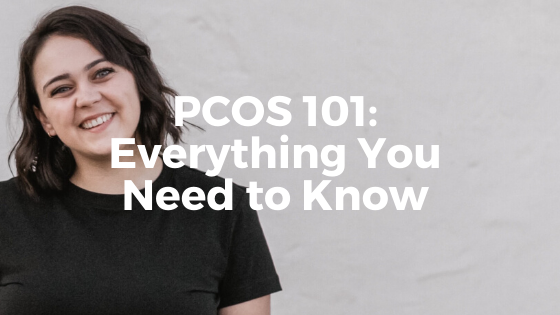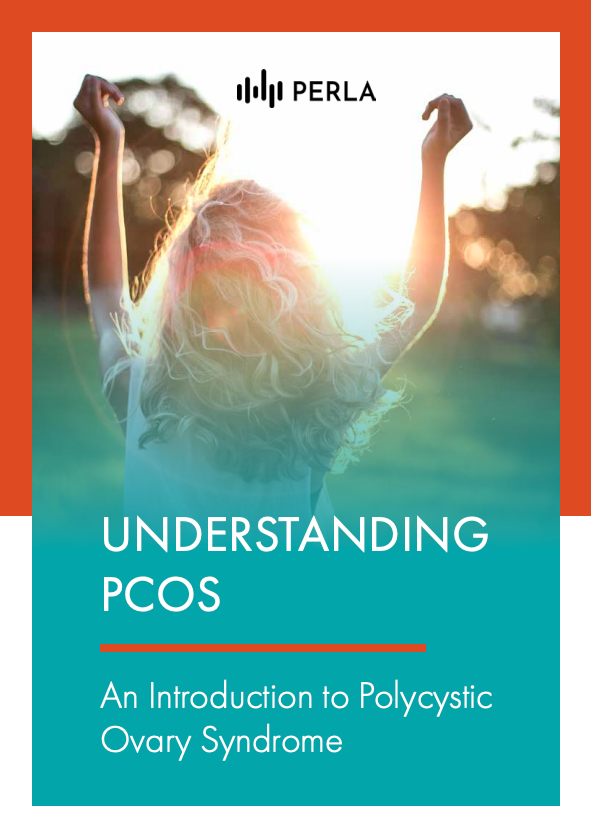If you are confused about your PCOS diagnosis or PCOS in general, you are not alone. Science still doesn’t have a complete understanding of how the syndrome develops.
PCOS is more common than you think, affecting between 5% and 20% of women between the ages of 15 to 49 worldwide. Women with PCOS often experience irregular menstruations, facial and body hair growth (hirsutism), weight gain, acne, and infertility.1 Learning more about PCOS is crucial, especially after the diagnosis. For those who have a difficult time getting the answers they need, let’s dive right in and find out everything you need to know about PCOS.
What is Polycystic Ovary Syndrome (PCOS)?
Even experts find it difficult to define polycystic ovary syndrome. The literal translation of the word polycystic is “many cysts,” but you don’t need to have polycystic ovaries to be diagnosed with PCOS. Likewise, some women with ovarian cysts do not have PCOS. The “cysts” in a polycystic ovary are not actual cysts but ovarian follicles that house your immature egg cells.2
What we now know is that PCOS is not only a gynecological concern but a metabolic syndrome, characterized by elevated levels of androgen (male hormones), menstrual irregularities, and insulin resistance.3 There is a wide spectrum of symptoms which can also overlap with other medical conditions.
Symptoms of PCOS
PCOS is a heterogeneous syndrome, which means its signs and symptoms differ from patient to patient. So the symptoms you experience most with PCOS might be quite different from what another woman with PCOS experiences. Some women may have excess body hair without irregular menstruations, while others may have trouble conceiving even without having signs of elevated male hormones, such as acne or excessive body hair. Half of the women with PCOS may not show any symptoms at all, or may have symptoms that do not match the classic presentations of the syndrome.
Women with PCOS often experience the following symptoms:
Common symptoms
- Excess body hair growth (Hirsutism)
- Weight gain or inability to lose weight
- Moderate to severe acne
- Infrequent periods or no periods
Less common symptoms
- Hair thinning
- Insulin resistance
- Mood changes
- Unexplained tiredness
- Acanthosis nigricans (darkening and thickening of the skin)
Common conditions linked to PCOS
- Type 2 Diabetes
- Obesity
- Heart problems and high blood pressure
- High levels of unhealthy cholesterol
- Sleep apnea
- Mood disorders (anxiety or depression)
One of the key features of PCOS is hyperandrogenism, in which the ovaries produce abnormal amounts of androgens, particularly testosterone. Having too much of this hormone prevents the normal release of egg cells from the ovaries, causing irregular menstruation and difficulty to conceive.4 Hyperandrogenism also often shows up as excess hair on the chin, upper lip, chest, and the abdomen, a receding hairline, and skin that is prone to breakouts.
Causes and Risk Factors
The reason why there are so many open questions around PCOS is that the exact cause of PCOS is still unknown. Several theories have been proposed, but most proved to be inconsistent and controversial, leaving us with no clear answer. It is believed to be the result of different interactions between genetic and environmental factors. Most experts agree that PCOS runs in the family, but the inherited disorder is more likely to show up under certain environmental and behavioral conditions, such as diet, medications, stress, and other lifestyle factors.5
Diagnosis
There is currently no single test that gives a definitive diagnosis of PCOS. Healthcare providers take different approaches, but the most widely used diagnostic tool is the Rotterdam Criteria for PCOS.
In the Rotterdam Criteria, several research groups agreed that satisfying two of three criteria below is enough to qualify for the diagnosis of polycystic ovary syndrome.6
- Menstrual irregularities (irregular ovulation (oligo-ovulation) or total absence of ovulation (anovulation))
- Elevated levels of androgens in the blood; signs of androgen excess such as hirsutism, obesity, and acne, among others
- Polycystic Ovaries: 12 or more follicles per ovary, or >10ml of ovarian volume
Your doctor will perform a series of tests to determine if you have PCOS or if you have other medical conditions that mimic the syndrome. Such tests will likely involve:
- your medical and family history
- physical examination
- blood tests to measure hormone levels
- transvaginal ultrasound to check for polycystic ovaries
Essentially, thyroid dysfunctions, tumors of the adrenal gland, Cushing syndrome, and other causes must be ruled out before making a diagnosis.
Treatment Options 7,8
Once you have been diagnosed, your healthcare provider and you will likely discuss the treatment options. There currently is no cure for PCOS. Medications, lifestyle interventions, and other therapies help in managing symptoms. Therapies are tailored to your symptoms and needs, particularly if you desire to become pregnant or not. Discuss with your doctor and PCOS care team to find the treatment approach that works best for you. These are some of the options to discuss:
Lifestyle modifications
Lifestyle changes are first-line treatment for PCOS and even small changes of 5 – 10% are known to improve ovulation and metabolic dysfunction. Reduction of body weight among overweight or obese women with PCOS can reduce androgen levels, promote normal menstruation, and can also improve fertility.9
Diet and exercise can help with weight loss; however, most studies only show moderate or no weight loss10 even with intense workouts. Still, exercise programs are highly recommended as they improve insulin resistance and reduce cardiovascular risk.
Medications for PCOS
There are several medications that are used for symptom management of PCOS that your doctor might mention. Make sure to listen to and follow your doctor’s advice on what is most appropriate for your specific situation and your goals. The medications that are most often mentioned as an option are:
- Hormonal contraception, such as birth control pills, contraceptive injections and patches, are used to treat hyperandrogenism.
- Infertility medications are drugs that stimulate ovulation, if you want to get pregnant. Clomiphene citrate is the most commonly used treatment for infertility.
- Anti-diabetic medications like metformin lower androgen levels and improve ovulation rate.
- Anti-androgen medications are usually prescribed to treat male-pattern baldness and reduce excess hair growth.
Work closely with your doctor and PCOS care team to find out if medication could work for you and your goals, and which medication would be most appropriate for your situation.
Managing physical symptoms
For many of the physical symptoms, cosmetic measures are also used to manage them:
- Hirsutism (Excess Hair Growth) – shaving, depilatories, plucking/waxing, laser treatment
- Acne – retinoids, oral and topical antibiotic
- Baldness – solutions or shampoos containing agents such as minoxidil
- Acanthosis nigricans – lightening agents, dermabrasion, laser therapy
Check in with your dermatologist on what would work best for you.
Long-Term Health Risks
PCOS is also associated with several other medical complications, including infertility, obesity, diabetes, endometrial cancer, and cardiovascular diseases.
It does not mean you will inevitably become infertile or diabetic if you have PCOS. It does not mean you will develop malignancies or heart problems. But, you have a higher chance of developing some of these conditions compared to individuals without PCOS. For instance, the risk of endometrial cancer in women with PCOS is 2.7 times higher than in women without the syndrome.11 Obesity is observed in about 50% to 80% of women with PCOS.12 In the United States, up to 35% of patients have impaired glucose tolerance,13 which puts them at risk of developing type 2 diabetes.
Make sure to check in regularly with your doctor or PCOS care team to monitor your general health and well-being , and schedule regular appointments for the prevention of these long-term health risks. Ask your doctor about how frequently you should check in with them for preventive appointments.
Conclusion
The diagnosis of PCOS can be very distressing. However, do not be discouraged. You can control PCOS. Find a doctor, a OB-GYN, reproductive endocrinologist or your primary care provider/general practitioner that you trust and feel comfortable to continue working along your journey with PCOS. It’s important to get an early diagnosis, as it can reduce your long-term risks. After your diagnosis, focus on working closely with your doctor and PCOS care team to make sure you achieve your goals towards a better life with PCOS.
Sources:
- Azziz R, Carmina E, Chen Z et al. Polycystic ovary syndrome. Nature Reviews Disease Primers 2. 2016. doi:10.1038/nrdp.2016.57
- Khadilkar SS. Polycystic Ovarian Syndrome: Is It Time to Rename PCOS to HA-PODS?. J Obstet Gynaecol India. 2016;66(2):81‐87. doi:10.1007/s13224-016-0851-9
- “Polycystic Ovary Syndrome”, Genetics Home Reference. https://ghr.nlm.nih.gov/condition/polycystic-ovary-syndrome. Accessed April 30, 2020.
- Stracquadanio M, Ciotta L. Metabolic Aspects of PCOS: Treatment with Insulin Sensitizers.; 2015.
- Barry J. Psychological Aspects of Polycystic Ovary Syndrome. London: Palgrave Macmillan; 2019:17.
- Revised 2003 consensus on diagnostic criteria and long-term health risks related to polycystic ovary syndrome (PCOS). Human Reproduction. 2004;19(1):41-47. doi:10.1093/humrep/deh098
- Legro R. Diagnosis and treatment of polycystic ovary syndrome (PCOS): An interview with Richard Legro. BMC Med. 2015;13(1). doi:10.1186/s12916-015-0299-2
- McCartney C, Marshall J. Polycystic Ovary Syndrome. New England Journal of Medicine. 2016;375(1):54-64. doi:10.1056/nejmcp1514916
- Lim S, Clifton P, Noakes M, Norman R. Obesity Management in Women with Polycystic Ovary Syndrome. Women’s Health. 2007;3(1):73-86. doi:10.2217/17455057.3.1.73
- Harrison C, Stepto N, Hutchison S, Teede H. The impact of intensified exercise training on insulin resistance and fitness in overweight and obese women with and without polycystic ovary syndrome. Clin Endocrinol (Oxf). 2012;76(3):351-357. doi:10.1111/j.1365-2265.2011.04160.x
- Dumesic D, Lobo R. Cancer risk and PCOS. Steroids. 2013;78(8):782-785. doi:10.1016/j.steroids.2013.04.004
- Dumesic D, Oberfield S, Stener-Victorin E, Marshall J, Laven J, Legro R. Scientific Statement on the Diagnostic Criteria, Epidemiology, Pathophysiology, and Molecular Genetics of Polycystic Ovary Syndrome. Endocr Rev. 2015;36(5):487-525. doi:10.1210/er.2015-1018
- Ehrmann D, Barnes R, Rosenfield R, Cavaghan M, Imperial J. Prevalence of impaired glucose tolerance and diabetes in women with polycystic ovary syndrome. Diabetes Care. 1999;22(1):141-146. doi:10.2337/diacare.22.1.141


